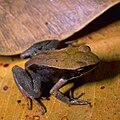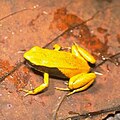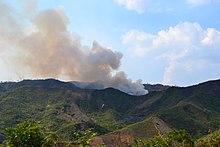| Mantella | |
|---|---|

| |
| Golden mantella (Mantella aurantiaca) from the Ramsar Menalamba site, Torotorofotsy Wetlands Reserve. | |
|
Scientific classification
| |
| Domain: | Eukaryota |
| Kingdom: | Animalia |
| Phylum: | Chordata |
| Class: | Amphibia |
| Order: | Anura |
| Family: | Mantellidae |
| Subfamily: | Mantellinae |
| Genus: |
Mantella Boulenger, 1882 |
| Type species | |
|
Dendrobates betsileo
Grandidier, 1872
| |
| Diversity | |
| 16 species | |
Mantella (also known as golden frogs or Malagasy poison frogs) are a prominent genus of aposematic frogs in the family Mantellidae, endemic to the island of Madagascar. [1] Members of Mantella are diurnal and terrestrial, with bright aposematic coloration or cryptic markings.
Natural history
Mantella are an example of convergent evolution—the independent evolution of a similar trait with species of a different lineage—with the Latin American family Dendrobatidae in size, appearance, and some behavioral characteristics. During the description of the first specimens from 1866 to 1872, Alfred Grandidier described both the brown mantella (Mantella betsileo) and Malagasy mantella (Mantella madagascariensis) and placed them within the genus Dendrobates based on their close resemblance.
This placement was heavily debated until 1882, when George Albert Boulenger created the genus Mantella after describing both Cowan's mantella (Mantella cowanii) and, in 1888, Baron's mantella (Mantella baroni). M. baroni was named after the gentleman that collected the specimens, Rev. Richard Baron, a missionary and botanist living in Madagascar. Baron was also interested in geology and herpetology, collecting many specimens during his extensive expeditions across the country. This species is incredibly similar in coloration to M. madagascariensis, except for the ventral/underside markings. In 1889, after the description of M. baroni, French naturalist Alexandre Thominot described Phrynomantis maculatus, with its type locality on Réunion Island. However, this locality was later corrected to the off-shore Malagasy islands of Nosy Bé and Nosy Komba and P. maculatus was synonymized with M. baroni.
The genus remained within Dendrobatidae until the late 19th century. The Royal Natural History (1893) by Richard Lydekker included the genus Mantella as one of two genera representing Dendrobatidae, saying that they could be "distinguished by the tip of the tongue being notched; while in Dendrobates of Tropical America the tongue is entire." [2]
During the first quarter of the 20th century, another three species of Mantella were described, including the golden mantella (Mantella aurantiaca), by the French herpetologist François Mocquard in 1900. In his work "Synopsis des familles, genres et espèces des reptiles écailleux et des batraciens de Madagascar" published in 1909, Mocquard gave a detailed description of Mantella and the species within the genus. Within the document, six species are described, including one unusual description of Mantella attemsi, described in 1901 by Franz Josef Maria Werner, an Austrian zoologist and explorer. Mocquard's work describes M. attemsi as follows: "First digit extends as far as the second. [Replilatero-dorsal] present, starting at the rear of the upper eyelid. Skin very porous, slightly rough on the back and the head, stomach side smooth; lower back of the legs very rough. Back a dark red-brown, rest of the body black." [3] This species was later synonymised with M. betsileo.
Description
Species of this genus are small, varying in length between 18–31 millimetres (0.71–1.22 in). [4] Most Mantella species are sexually dimorphic in size, with females being larger than males. Mantella vary in shape from streamlined to plump/rounded bodies, with skin that is either smooth or granular. They have small, angular heads, with large eyes that are either entirely dark or have lighter coloration around the edge of the iris. Mantella have a very distinct tympanum. The tips or discs of the fingers are slightly enlarged, though those of the climbing mantella (Mantella laevigata) are distinctly larger than in other members of the genus. They have four fingers on each forelimb and five on each hindlimb; some species have webbed digits, while others do not. The tibiotarsal articulation is roughly between the shoulder and the nostrils.
Many species of Mantella are similar to the neotropical family Dendrobatidae in their use of aposematism (from Greek ἀπό apo away, σῆμα sema sign), a defense mechanism that uses dramatic coloration to deter potential predators. Coloration and markings vary between species, with combinations of green, red, orange, yellow, blue, brown, white and black. These colorations are often evidence that the specimen produces toxic, pharmacologically active alkaloid secretions. There are significant similarities between a few species of Mantella and Dendrobatidae, notably the golden mantella (Mantella aurantiaca) and the golden poison frog (Phyllobates terribilis). Cowan's mantella (Mantella cowanii) and certain variations of the Harlequin poison frog (Oophaga histrionica) are also very similar in coloration. Most members of the genus also exhibit aposematism on the ventral region, excluding the golden mantella and black-eared mantella (Mantella milotympanum). The venter is normally uniform black, dark grey, or brown and are often marked with blueish or white spots, flecks, or blotches. There are similar blueish to white markings in the form of either spots or a continuous horseshoe-shaped marking on the vocal sac. These characteristics can be used to distinguish between species, such as Baron's mantella (Mantella baroni) and the Malagasy mantella (Mantella madagascariensis), when locality data is unavailable.
Mantella show a variety in alkaloid profiles between individual frogs of the Ranomafana region. These same alkaloids have been found to be sequestered by certain insects. It has also been observed that Mantella retain alkaloids in their skin for years in captivity. This, combined with analyses of stomach contents and diet, suggests that members of Mantella obtain at least some of their alkaloids from arthropod prey. [5]
Distribution


Mantella are endemic to the island of Madagascar and its smaller coastal islands ("Nosy" in Malagasy). They inhabit a wide variety of different habitat types including primary rainforests, secondary rainforests, swamps, bamboo forests, semi-arid streambeds, slow moving forest streams, seasonal streams, montane grassland savannah, and wet canyons. [4] [6] [7]
Some members of the genus such as Ebenau's mantella (Mantella ebenaui), the brown mantella (Mantella betsileo), and Cowan's mantella (Mantella cowanii) are highly adaptable and have been reported in a wide variety of habitats. On the island of Nosy Boraha (Sainte Marie), M. ebenaui have been found living in garbage dumps, feeding on flies. Similar behavior has been reported in western Madagascar, with M. betsileo inhabiting rubbish piles behind human dwellings.
Locality variations
There are several populations of Mantella species that exhibit unusual coloration, some of which are intermediates between species living in sympatry. For example, there are populations of yellow mantella (Mantella crocea) and black-eared mantella (Mantella milotympanum) found in Fierenana, Andriabe, Ambohitantely Reserve and Savakoanina that have green, red and yellow colourations. This often makes it difficult to distinguish between the two species. [4]
Populations of Baron's mantella (Mantella baroni) have also been reported at Pic d'Ivohibe Reserve, being almost entirely green in coloration with black patches and spotting, and lacking their distinctive orange and irregular black crossbands. These specimens are referred to as Mantella aff. baroni. [8]
Malagasy mantella (Mantella madagascariensis), a species similar in appearance to M. baroni, is also notably variable among different localities. Niagarakely is one such locality within the Anosibe An'ala District of the Alaotra-Mangoro Region. Here, M. madagascariensis exhibit highly broken yellow/green and mottled black dorsal coloration.
Species
There are currently 16 species of Mantella, with five recognized species groups. [1] [4] Most species are easily identifiable by their color patterns, although there are a number of locality variations with an uncertain taxonomic status. [4]
| Species group | Image | Binomial (scientific name) | Common name | IUCN conservation status | Distribution |
|---|---|---|---|---|---|
| Mantella laevigata group |

|
Mantella laevigata Methuen & Hewitt, 1913 | Climbing mantella | Least Concern | northeastern Madagascar |
| Mantella manery Vences, Glaw & Böhme, 1999 | Marojejy mantella | Vulnerable | northern Madagascar | ||
| Mantella betsileo group |

|
Mantella betsileo Grandidier, 1872 | Brown mantella | Least Concern | western & central Madagascar |

|
Mantella ebenaui Boettger, 1880 | Ebenau's mantella | Least Concern | northeastern Madagascar | |

|
Mantella expectata Busse & Böhme, 1992 | Blue-legged mantella | Endangered | southwestern Madagascar | |

|
Mantella viridis Pintak & Böhme, 1988 | Green mantella | Endangered | northern Madagascar | |
| Mantella bernhardi group |

|
Mantella bernhardi Vences, Glaw, Peyrieras, Böhme & Busse, 1994 | Bernhard's mantella | Vulnerable | southeastern Madagascar |
| Mantella cowanii group |

|
Mantella cowanii Boulenger, 1882 | Cowan's or harlequin mantella | Endangered | central Madagascar |

|
Mantella baroni Boulenger, 1888 | Baron's mantella | Least Concern | central Madagascar | |

|
Mantella haraldmeieri Busse, 1981 | Harald Meier's mantella | Endangered | southern Madagascar | |

|
Mantella nigricans Guibé, 1978 | Guibe's mantella | Least Concern | northeastern Madagascar | |
| Mantella aurantiaca group |

|
Mantella aurantiaca Mocquard, 1900 | Golden mantella | Endangered | central Madagascar |

|
Mantella crocea Pintak & Böhme, 1990 | Yellow mantella | Vulnerable | central Madagascar | |

|
Mantella madagascariensis Grandidier, 1872 | Malagasy mantella | Vulnerable | central Madagascar | |

|
Mantella milotympanum Staniszewski, 1996 | Black-eared mantella | Critically Endangered | eastern Madagascar | |

|
Mantella pulchra Parker, 1925 | Beautiful mantella | Near Threatened | eastern Madagascar |
Threats

Several species in the genus are threatened because of habitat loss (due to subsistence agriculture, timber extraction and charcoal production, fires, draining of wetlands, the spread of invasive eucalyptus, and expanding human settlements), mining, hybridization and over-collection for the international pet trade. [6] As a result of these threats, various Mantella sp. are listed as least concern, near threatened, vulnerable, endangered, and critically endangered by the IUCN Red List of Threatened Species.
Species in this genus have tested positive for Batrachochytrium dendrobatidis (Bd). As of yet, there have been no negative effects observed within amphibian populations in Madagascar, suggesting that the Bd strain has a low virulence level but should be closely monitored. [6]
Gallery
-
Mantella aurantiaca
-
Mantella baroni
-
Mantella bernhardi
-
Mantella cowanii
-
Mantella expectata
References
- ^ a b Frost, Darrel R. (2017). "Mantella Boulenger, 1882". Amphibian Species of the World: an Online Reference. Version 6.0. American Museum of Natural History. Retrieved 6 January 2018.
- ^ Lydekker, Richard (1893). The Royal Natural History Vol. V - Reptiles, Amphibians and Fishes. Frederick Warne & Co. p. 271.
- ^ Mocquard, Francois (1909). "Synopsis des familles, genres et espèces des reptiles écailleux et des batraciens de Madagascar (1909)". Masson: 65–67.
- ^
a
b
c
d
e Glaw, Frank; Vences, Miguel (2007). A Field Guide to the Amphibians and Reptiles of Madagascar (3 ed.). Köln. p. 188.
ISBN
978-3-929449-03-7.
{{ cite book}}: CS1 maint: location missing publisher ( link) - ^ Clark, V.C.; Rakotomalala, V.; Ramilijaona, O.; Abrell, L.; Fisher, B.L. (2006-10-01). "Individual Variation in Alkaloid Content of Poison Frogs of Madagascar (Mantella; Mantellidae)". Journal of Chemical Ecology. 32 (10): 2219–2233. doi: 10.1007/s10886-006-9144-6. ISSN 1573-1561. PMID 17013661. S2CID 12171450.
- ^ a b c "The IUCN Red List of Threatened Species". The IUCN Red List of Threatened Species. 2017.
- ^ Staniszewski, Marc (2001). Mantellas. Edition Chimaira. ISBN 978-3930612543.
- ^ Vences, Miguel; Glaw, Frank; Mausfeld, Patrick; Böhme, Wolfgang (October 1998). "Comparative osteology of Malagasy poison frogs of the genus Mantella" (PDF). Zoological Bulletin. 48: 206.
External links
- Clark, Valerie C.; Raxworthy, Christopher J.; Rakotomalala, Valérie; Sierwald, Petra; Fisher, Brian L. (16 August 2005). "Convergent evolution of chemical defense in poison frogs and arthropod prey between Madagascar and the Neotropics". Proceedings of the National Academy of Sciences. 102 (33): 11617–11622. Bibcode: 2005PNAS..10211617C. doi: 10.1073/pnas.0503502102. PMC 1187980. PMID 16087888.
- AmphibiaWeb: Information on amphibian biology and conservation. [web application]. 2008. Berkeley, California: Mantella. AmphibiaWeb, available at http://amphibiaweb.org/. (Accessed: June 8, 2008).
- eol - Encyclopedia of Life taxon Mantella at http://www.eol.org.
- ITIS - Integrated Taxonomic Information System on-line database Taxon Mantella at https://web.archive.org/web/20160606043808/http://www.itis.gov/index.html. (Accessed: June 8, 2008).
- GBIF - Global Biodiversity Information Facility Taxon Mantella at https://web.archive.org/web/20080501142231/http://data.gbif.org/welcome.htm
- Mantella Conservation
- Poison Frogs of Madagascar: Mantella
- Vences, M.; Glaw, F.; Böhme, W. (1999). " A review of the genus Mantella (Anura, Ranidae, Mantellinae): taxonomy, distribution and conservation of Malagasy poison frogs" (PDF). Alytes. 17 (1–2): 3–72.



